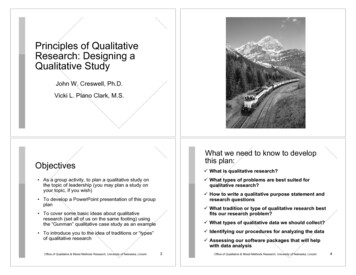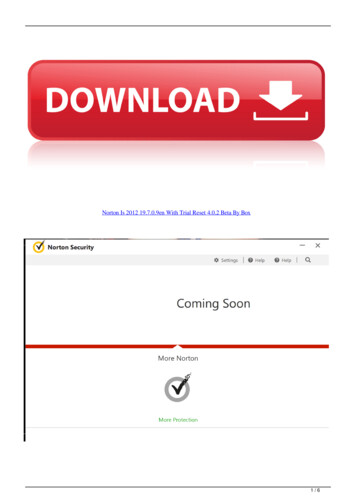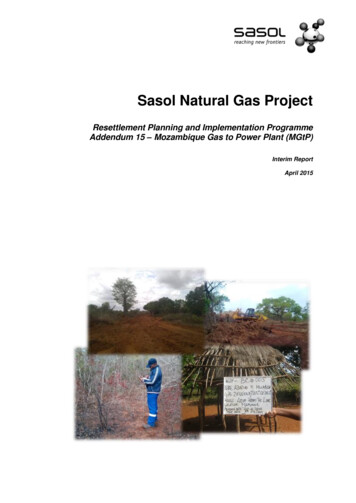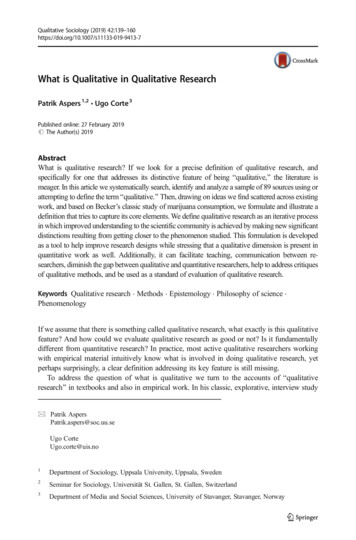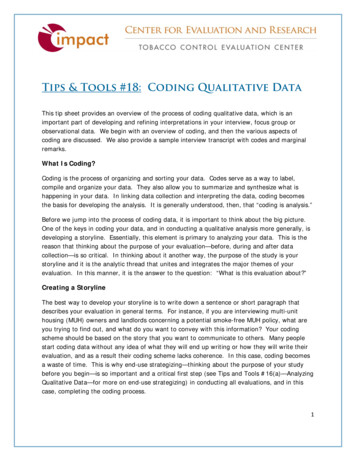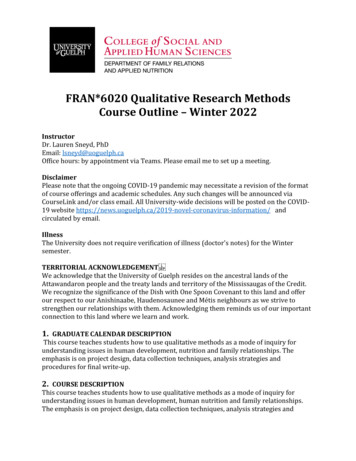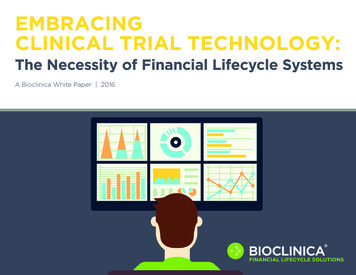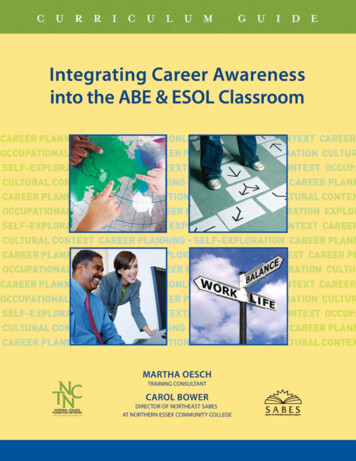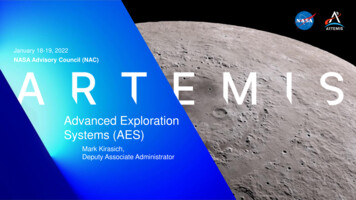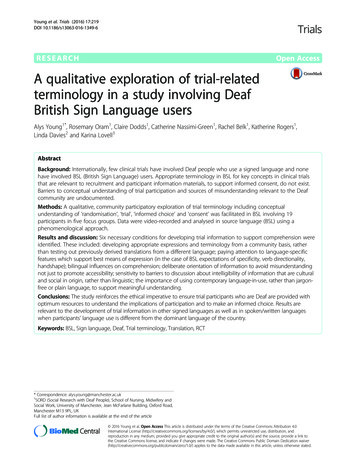
Transcription
Young et al. Trials (2016) 17:219DOI 10.1186/s13063-016-1349-6RESEARCHOpen AccessA qualitative exploration of trial-relatedterminology in a study involving DeafBritish Sign Language usersAlys Young1*, Rosemary Oram1, Claire Dodds1, Catherine Nassimi-Green1, Rachel Belk1, Katherine Rogers1,Linda Davies2 and Karina Lovell3AbstractBackground: Internationally, few clinical trials have involved Deaf people who use a signed language and nonehave involved BSL (British Sign Language) users. Appropriate terminology in BSL for key concepts in clinical trialsthat are relevant to recruitment and participant information materials, to support informed consent, do not exist.Barriers to conceptual understanding of trial participation and sources of misunderstanding relevant to the Deafcommunity are undocumented.Methods: A qualitative, community participatory exploration of trial terminology including conceptualunderstanding of ‘randomisation’, ‘trial’, ‘informed choice’ and ‘consent’ was facilitated in BSL involving 19participants in five focus groups. Data were video-recorded and analysed in source language (BSL) using aphenomenological approach.Results and discussion: Six necessary conditions for developing trial information to support comprehension wereidentified. These included: developing appropriate expressions and terminology from a community basis, ratherthan testing out previously derived translations from a different language; paying attention to language-specificfeatures which support best means of expression (in the case of BSL expectations of specificity, verb directionality,handshape); bilingual influences on comprehension; deliberate orientation of information to avoid misunderstandingnot just to promote accessibility; sensitivity to barriers to discussion about intelligibility of information that are culturaland social in origin, rather than linguistic; the importance of using contemporary language-in-use, rather than jargonfree or plain language, to support meaningful understanding.Conclusions: The study reinforces the ethical imperative to ensure trial participants who are Deaf are provided withoptimum resources to understand the implications of participation and to make an informed choice. Results arerelevant to the development of trial information in other signed languages as well as in spoken/written languageswhen participants’ language use is different from the dominant language of the country.Keywords: BSL, Sign language, Deaf, Trial terminology, Translation, RCT* Correspondence: alys.young@manchester.ac.uk1SORD (Social Research with Deaf People), School of Nursing, Midwifery andSocial Work, University of Manchester, Jean McFarlane Building, Oxford Road,Manchester M13 9PL, UKFull list of author information is available at the end of the article 2016 Young et al. Open Access This article is distributed under the terms of the Creative Commons Attribution 4.0International License (http://creativecommons.org/licenses/by/4.0/), which permits unrestricted use, distribution, andreproduction in any medium, provided you give appropriate credit to the original author(s) and the source, provide a link tothe Creative Commons license, and indicate if changes were made. The Creative Commons Public Domain Dedication o/1.0/) applies to the data made available in this article, unless otherwise stated.
Young et al. Trials (2016) 17:219BackgroundSigned languages such as BSL (British Sign Language) arenaturally occurring, grammatically complete languages[1]. They are not visual versions of the dominant spokenlanguage of the countries where they are used. For Deafpeople who use their native signed language, its use is amarker of cultural identity and a gateway to a commoncommunity whose traditions and histories in each countryaround the world stretch back over many centuries [2–4].Yet Deaf communities around the world have experiencedoppression through a failure to recognise their languageand culture [2]. BSL only gained formal recognition as anindigenous language of the UK in 2003 [5] and only inScotland has a law recently been passed conferring legalrights and duties towards BSL users [6].English predominates as the language of education forDeaf children; for example, in England 87 % of deafchildren only use spoken language in the school environment [7]. Fewer than 5 % of deaf children have one or moreparent who is Deaf [8]; therefore, it is more usual for BSLnot to be acquired from within one’s birth family. Also,Deaf culture is rarely passed inter-generationally with manyyoung Deaf people forming their Deaf cultural identity asyoung adults through peers and Deaf community involvement [9]. In previous generations, it was more usual fordeaf children to attend specialist deaf schools, often residentially, where sign language and Deaf culture wereabsorbed at an early age, even in those which were spokenlanguage educational environments.In the United Kingdom, population estimates for BSLusers range from 28,000 to over 100,000 [10] with a conservative estimate of around 70,000 being commonly cited[11]. Culturally, Deaf people who sign are often marked inliterature by the use of a capital ‘D’ to distinguish themfrom the much larger population of deaf people who donot sign; a convention we follow here [12].Although the health inequalities that Deaf people experience are increasingly recognised [13–16] and thedistinct needs of Deaf people in terms of access to healthservices and care are a focus of interest [17], Deaf peopleare largely invisible in the clinical trials literature. Theinvisibility occurs both because Deaf sign language usersare commonly excluded from trial participation becauseof the likely confounding variables they would introduce(see [18], chapter 5) and because there is almost no clinical trial work on an international basis that is focusedspecifically on Deaf people; for a rare exception see [19].Using language to explore language, and in particular, terminology, has inherent challenges because language is boththe subject and process of the endeavour; it is the referentand the means of reference ([20], p.15). Furthermore, familiarity with a word (lexical item) does not always confer familiarity with its meaning. In everyday life we all haveknowledge of words whose meaning eludes us or wordsPage 2 of 12whose meaning we are sure of, only to realise that we havemisunderstood. This is further complicated in communication between researchers of different disciplines, who attach different technical meanings to the same term.Communication between researchers and non-researchersfaces similar problems compounded by a wide range of laymeanings attached to concepts and words. For example,‘efficiency’ to the economist means maximising benefit fora given budget or minimising the cost of achieving a givenoutcome. In lay terms, for the general population andother research disciplines, ‘efficiency’ is often used to denote simply cost-cutting with no regard to outcome.Yet using language to talk about language and its meaning is not an impossible task. Terminology (‘jargon’) can actlike a placeholder – its potential ambiguity, obscurity, lackof transparency or multiple meanings are accepted on atemporary basis whilst it is talked about. Encyclopaedic understanding of how the words we use are defined is usuallynot required for us to use them in everyday life [21]. Wecan choose our words on the basis of our linguistic knowledge (ibid) only, having experience of when or how termsmight be used without fully understanding them.This approach has formed the basis of many studieswhich have sought to understand participants’ understandings of familiar terminology in clinical trial designs and thecommon assumptions associated with words such as ‘randomisation’, ‘trial’, ‘consent’, ‘placebo’, ‘arm’[22–24]. The findings have revealed understandings and misunderstandingsof key concepts and have been used to help improve participation in trials through ensuring that the information isrelevant, appropriate and accessible [25, 26]. From an ethical perspective, supporting understanding and avoidingmisunderstanding are crucial to informed consent.In relation to Deaf participants who use BSL, three keysources of complexity in producing relevant and accessible recruitment-related information are likely to be: (1)background (general) knowledge considerations associated with Deaf people, (2) properties of a visual spatiallanguage, and (3) bilingual considerations.In terms of background knowledge considerations, Deafpeople routinely experience considerable barriers to accessing information and the acquisition of knowledge, whetherdeliberately or incidentally. In part, this is because Deafpeople commonly experience highly limited access to information on a wide range of everyday subjects because it isnot available in a signed language [27, 28]. Secondly, themajority of Deaf people who have been deaf since birth orearly childhood, have lower than average levels of literacyin the written word in comparison with hearing people[29]. Also, the acquisition of incidental and everyday information is hampered by limited access to the spoken word.Finally, a paucity of peers who sign in the general environment reduces further the opportunities to pick up knowledge through casual conversation. Consequently, it is
Young et al. Trials (2016) 17:219recognised that many Deaf people experience what hasbeen termed a ‘low fund of information’ [30]. Therefore,many Deaf people, who are potential trial participants,might not be even casually familiar with the terms and concepts used in participant information sheets, informed consent forms and the verbal support available fromresearchers.In relation to the properties of a visual, spatial language, there are features of a signed language that potentially raise different challenges to spoken languages,which use terminology as temporary placeholders to explore understanding. For example, ambiguity and nonspecificity can be harder to convey in a language wherevisual specificity is integral to those signs that are iconicin nature [31]. A phrase such as ‘kill oneself ’, for example, that in English remains without any indication ofmeans, in BSL would be more difficult to convey without an assumption of manner of death in how it issigned (see [32] for more examples).Signed expressions that operate as temporary placeholders to facilitate discussion are also potentially problematic within a visual language. This is because theirform can influence the conceptual understanding of participants unfamiliar with the term; the shape, orientationor movement involved in a signed expression can revealunderlying assumptions associated with its meaning. Forexample, EXPERIMENTAL STUDY1 might be expressed,at least initially, using signs drawn from the common lexicon, such as EXPERIMENT followed by STUDY, until thetrue meaning can be discussed and an appropriate signedphrase arrived at. However, the sign for EXPERIMENT isnot vague; it is usually an iconic representation of testtubes being poured. This immediately introduces the notion of laboratory science rather than an experimental studypotentially involving complex interventions of people, behaviour and therapies. The temporary placeholding signsets up unwelcome initial assumptions and implications because of how it looks even if those involved are aware it isacting as a placeholder. Finger spelling2 the English form ofa term is a common way to get round this problem – onemay spell out e-x-p-e-r-i-m-e-n-t-a-l – however, to do sointroduces a bilingual aspect into an otherwise monolingualdiscussion and requires acts of translation.In terms of bilingual considerations, although the firstand/or preferred language of Deaf trial participants isBSL, no Deaf person in England is growing up in amonolingual environment. The written word and thespoken word are everywhere. Deaf individuals will,therefore, have differing degrees of access to, and familiarity with, English (or other spoken/written languages)that will have an influence on conceptual understandingas well as basic knowledge. There are examples wherethe written form of a word might influence the signedlexicon, e.g. the Isle of Wight used to commonly bePage 3 of 12signed as ISLE of WEIGHT. In other cases the phoneticproperties of the surrounding spoken language can bean influence as in the case of Preston (the city), beingsigned as PRIEST, because the shape on the lips of Preston and Priest are similar. Also for Deaf people who, likehearing people, may be prodigiously bilingual or multilingual, there are just some words and expressions morefamiliar in one language than another and the ability tocode switch between languages can be a strength.In 2014 we were funded by the National Institute forHealth Research in England to undertake the preparatorywork required for a feasibility study leading to a clinical trialinvolving Deaf people in the context of a primary mentalhealth intervention . The programme known as BSL HealthyMinds [33] is an adaptation of the National Institute forHealth and Care Excellence (NICE) approved psychologicalintervention: Improving Access to Psychological Therapies(IAPT) [34]. It is delivered in BSL by Deaf trained practitioners and aimed at Deaf people experiencing commonmental health disorders including depression and anxiety.In line with the Medical Research Council (MRC) framework for complex interventions [35] a range of preparatorystudies were undertaken, one of which is the focus of thispaper: namely, exploring lay understanding amongst Deafpeople of key terminology and concepts associated withclinical trials. This was a necessary precursor to creatinglinguistically and culturally appropriate recruitment, information and consent materials for the forthcoming clinicaltrial.However, there were no previous randomised controlledtrials (RCTs) that involved Deaf people who use BSL. Thismeant that we were not seeking to improve participationbut rather to facilitate participation in the first place. Italso meant that there was no confirmed lexicon in BSL forcommon terms associated with clinical trials. This wastrue both of the sign bilingual university research department carrying out the study and for the everyday contextsof Deaf lives and conversation. Vocabulary and relevantforms of expression in any language only emerge when apopulation has direct experience of a topic; think, for example, of the evolution in English of vocabulary to matchthe explosion in information and communication technologies. As a consequence, the focus of our work in thestudy reported here was not on the translation into BSL ofkey terminology associated with clinical trials; it was on itsconceptual exploration with a linguistic community inorder to identify best means of signed expression and explanation, and likely barriers to comprehension.Specifically our aims were to: Explore, in BSL, the meaning and understanding ofkey concepts and common lexical items associatedwith recruitment and consent to a clinical trial
Young et al. Trials (2016) 17:219 Enable signs/signed expressions to emerge that aresemantically accurate and support Deaf people’sinformed consent in any future trial Identify key points that can inform the continueddevelopment of acceptable and accessible participantinformation for Deaf people who use BSL and arerecruited to clinical trialsWe anticipated that many participants in our studymight not be even casually familiar with the terms andconcepts we would be exploring, and that access to information that might support understanding of unfamiliar terms would be more limited than amongst hearinglay communities.MethodsMethodological approachThe qualitative research design is underpinned by a phenomenological approach [36]. Phenomenology draws attention to sense-making through social and communicativeinteractions and emphasises that meanings are not fixedbut are generated in context through the use of languageand the prior experiences and culture that individuals bringto an interaction [37]. This was an appropriate approachfor a study that was exploring conceptual understanding ofterms through group-based discussion (focus groups). It isalso an approach that enables cultural meanings to emergethrough analysis rather than a priori definitions to beassumed.RecruitmentAn explanation of the study in BSL was posted on theresearch group website and advertisements to participatein the focus groups were placed on a signed Facebooksite accessed by the Deaf community and through email,shared networks and word of mouth/word of hand. Apurposive sample was sought of Deaf people aged18 years or over, who used BSL as their first or preferredlanguage. Anyone currently receiving support throughthe IAPT programme was excluded because additionalethical permissions, over and above those required foran exploratory study, would be required if participantsincluded those who were current patients of theNational Health Service in England.EthicsThe study was approved by the University of ManchesterResearch Ethics Committee (Ref: 14183). Informed consent was obtained from all participants. Participant information sheets were made available in advance of the focusgroups in BSL on a website as well as in plain English.Prior to the focus groups, the researchers clarified the information in BSL again, face to face, and participants hadthe opportunity to ask questions. All participants werePage 4 of 12provided with a pre-written, postage paid withdrawal formto facilitate easily withdrawal of consent for their data tobe used subsequent to the focus groups.Data capture methodsData were collected through focus groups with Deafpeople which were facilitated in BSL by researchers whoare native signers (RO and CNG). Four focus groupswere held, in three different regions in England, involving 19 people in total (one group chose to meet on twooccasions rather than once for a longer period of time).The groups were in two parts, each lasting between 1.5and 2 hours with refreshments provided. In part 1, participants were introduced to the purpose of the studyand clinical trials in general. In part 2, discussion focused more specifically on how to provide good information in BSL to support recruitment and informedconsent. The specific terms that the group were asked todiscuss were: ‘randomisation’, ‘feasibility’, ‘informed choice’,‘trial’, ‘consent’ and ‘experimental study’. They were informed in advance that this would form the content of thediscussion. There were no interpreters present at the focusgroups because the facilitators, RO and CNG, are nativeBSL users sharing a common language with participants.Three cameras were used to capture the discussions. Thesewere time-coded enabling the later simultaneous display ofall interactions and communication for purposes of analysis. PowerPoint was initially used as a prompt to differentsections of the discussion. In some instances the promptswere visual diagrams, e.g. showing two arms of a trial andhow it relates to initial recruitment of a sample; in othersthe prompts were specific words written in English thatcould be referred back to as prompts during the discussion.ParticipantsAll participants were over the age of 30 years with threeover the age of 61. Of the 19, 2 were unemployed and 4 retired. The rest were in employment although the majorityof these were in part-time employment. The entire samplehad a self-declared strong Deaf identity. Table 1 shows distribution of numbers per group and characteristics.Data analysisAll data were kept in their source language for purposesof analysis. The video files were uploaded to Nvivo 10which has the facility to tag and segment video data, inthis case visual language data, for purposes of thematiccoding without the need to transcribe data. This was important because if the data were transcribed this wouldequal translation in the case of BSL data which have nowritten form. This contrasts with many spoken languageswhere to transcribe data is only to change its modality(from spoken to written) and not to translate [18, 38–40].All data were watched and re-watched independently by
Young et al. Trials (2016) 17:219Page 5 of 12Table 1 Participant af parents?Age BSLacquiredInvolvement inDeaf communityI feel I amculturally DeafHighest qualificationGroup 11aMaleWhite BritishYesFrom birthOften involvedVery much soPostgraduate diploma1bMaleWhite BritishNo4–7 yrsOften involvedVery much soVocational qualification1cFemaleWhite BritishNo12–16 yrsOften involvedQuite soSchool leaving certificate1dFemaleAsian Indian BritishNoOver 25Very involvedVery much soVocational qualification1eFemaleWhite BritishNoMissingOften involvedQuite soProfessional diplomaGroup 2Group 3Group 42aFemaleWhite BritishNo1–3 yrsMissingVery much soOn-the-job training2bFemaleWhite BritishNo4–7 yrsVery involvedVery much soVocational qualification2cFemaleWhite BritishNo4–7 yrsVery involvedQuite soMissing2dFemaleWhite BritishNo4–7 yrsStarted age 40Very much soVocational qualification2eFemaleWhite BritishYesFrom birthOften involvedVery much soMissing3aMaleAsian Indian BritishYesOver 25Often involvedQuite soMissing3bFemaleWhite BritishNo1–3 yrsOften involvedVery much soProfessional diploma3cMaleWhite BritishNoFrom birthOften involvedQuite soProfessional diploma3dFemaleWhite BritishNo8–11 yrsOften involvedVery much soPostgraduate certificate3eFemaleWhite JewishNoOver 25Often involvedSomewhatProfessional diploma4aFemaleWhite BritishNo4–7 yrsVery involvedVery much soUniversity degree4bFemaleJewishNo17–24 yrsOften involvedSomewhatMissing4cFemaleWhite BritishNo17–24 yrsVery involvedVery much soPostgraduate certificate4dFemaleWhite BritishNoOver 25Often involvedQuite soProfessional diplomaBSL British Sign Languagetwo researchers (CD and CNG) with the aim of creatingan initial coding framework.The two researchers carrying out the analysis broughtdifferent personal and professional biographies to thetask: one is a native Deaf sign language user from a Deaffamily who has worked for over 10 years in researchroles; the other is a hearing researcher who learned BSLas an adult and who has been a qualified and registeredsign language interpreter for 11 years, in addition to herresearch role. Their initial coding frameworks were compared and discussed with a third researcher (AY) whowas overseeing the analysis (a hearing late learner signerwho has worked in the Deaf studies field for 25 years).Many of the same themes had been identified arisingfrom specific examples in the data but were not clustered in exactly the same way in how they had beenorganised by the two researchers. Further, discussion ledto a framework consisting of the following four areasunder which there were additional layers/sub-themes(Table 2).Results and discussionThe following presents illustrative examples for eachtheme/sub-theme rather than an exhaustive description,for there were myriad examples associated with eachthat emerged from the analysis.Strengths and challenges arising from the properties of avisual languageAcceptance of generality/specificityBSL is a four-dimensional language, encompassing theusual spatial dimensions and time [41]. Users combinesigns from the established lexicon with productive signs(i.e. those produced in the moment to match intended expression), or classifier proforms, a term which in sign languages refers to a handshape used to describe theappearance, location, and/or movements of objects. ThisTable 2 Structure of data analysis, themes and sub-themesThemeSub-themesStrengths and challenges arising fromproperties of a visual languageAcceptance of generality/specificityVerb directionalityConceptual understandings/misunderstandings of common termsOrientation toward avoidanceof misunderstandingSubstitution of alternativewords/expressionBilingualness and English influences onunderstanding and expressionVisual decoding of EnglishwordsTests not discussionPower differentials in acquiring andgenerating new knowledgePerceptions of classLanguage in use
Young et al. Trials (2016) 17:219gives the utterance a high degree of specificity, somethingwe would not necessarily expect to see in a correspondingEnglish phrase. For example, whilst in English we mightsay ‘she opened the window’, in BSL the correspondingsigned phrase would include specific details of the formand movement of the window being talked about; was it asash window, a window that opened from the left, or theright, or a tilt window? The correct form and movementof the window would be reproduced in how the phrase‘she opened the window’ was signed.In the focus groups, there were numerous examples ofhow this accustomed expectation of specificity was bothhelpful and unhelpful to participants exploring the meaning of unfamiliar terms; for example, RANDOMISATION.One approach to signing this conceptually would be to setup in space two locations, one to the right and one to theleft, to which people might be randomised as in differingarms of a trial. Given that in BSL space carries semanticsignificance, this approach clarifies easily the notion ofthere being two potential destination groups to which onemight be randomised. However, in one of the focusgroups, the signing of randomisation to incorporate twodestination spatial locations led to the not unreasonablequestion of whether there was ever the possibility of randomisation into more than two groups? If so, then thiselement of how randomisation might be signed wouldhave to be modified to encompass three or more visual locations in front of the signer to be accurate. Expectationsof visual specificity were being linked to the methodological basis of the trial design; thus, warning of the importance of accuracy at this level if later misunderstandingwere to be avoided.In another group, participants felt strongly that it wasimportant to know where the things/people to be randomised were being drawn from; in one case, it was suggested the sign for RANDOMISATION be preceded byan indication of the whole of England to make explicitthe idea that participants could come from across thecountry. This in turn would modify how the idea of randomisation would be expressed. Of course, written information sheets in English, for example, might includeinformation about the scope of recruitment under a section on why the individual is being asked to participate.However, in this example, the difference is that participants were of the view that where people might bedrawn from directly affected how the concept of randomisation should be expressed in BSL. This contextual,semantic layering of aspects of information within a single expression is very common in signed languages,whereas in written languages a sequential approach toaspects of information is more usual.Another aspect of BSL, handshape, also created potential for both confusion and illumination with respect tounderstanding RANDOMISATION because of highPage 6 of 12expectations of specificity. In BSL, handshapes mayiconically take on the visual representation of a subject/object as in the commonly used shape for a telephone,for example, which involves extending the thumb andlittle finger whilst folding away the others to make a representation of a telephone receiver or handset. Handshape in BSL can also take on a classifier form, that is tosay conventionalised (stylised) shapes that stand in for asubject/object, such as a flat hand for a car, or an extended vertical index finger for a person. In our study,one of the potential ways to sign randomisation involvedmovement away from the body by each of the hands sequentially toward the destination locations whilst shaping each hand to represent what it was that was beingrandomised. By utilising a handshape that is the classifier for an individual or the handshape that is the classifier for a group, the same signed expression could eitherindicate an RCT where the individual is the unit of randomisation or an RCT where the group is the unit ofrandomisation. But it is the same expression; the slightalternation of the handshape is what reveals this aspectof the underpinning research design.In summary, BSL users often expect visual specificityto be present, and for it to be grammatically correct inrelation to what is being described. This means they maybe less tolerant of, or less comfortable with, generalitywithin statements than English speakers may be. Consequently, it is important that the signs to describe and explain randomisation are both grammatically correct andconceptually more specific than the English written orspoken counterpart. This involves, essentially, payingclose attention to the visual grammatical properties ofsigned languages and ensuring they accurately portraythe underpinning trial design so as to promote conceptual understanding and avoid later misunderstandings bythose participating. The need for visual specificity is akey step in developing conventionalised signs for participant information and recruitment into prospective randomised and non-randomised evaluations.Verb directionalityAnother feature of BSL which is not present in Englishis verb directionality. Where in English the directionalityof the verb must be described separately from the verbitself (e.g. Sarah asked Jane), in BSL once Sarah and Janehave been established in signing space, the movement ofthe verb TO ASK from one place to another is sufficientto specify who is asking and who is being asked. Thisfeature generated considerable discussion within thegroups, particularly with reference to the idea ofINFORMED CHOICE.In English, ‘informed choice’ can be confusing giventhat ‘informed’ as an adjective implies having or showingknowledge of a subject or situation, and as a verb is the
Young et al. Trials (2016) 17:219past tens
ings of familiar terminology in clinical trial designs and the common assumptions associated with words such as 'ran-domisation', 'trial', 'consent', 'placebo,' 'arm'[22-24]. The find-ings have revealed understandings and misunderstandings of key concepts and have been used to help improve par-
